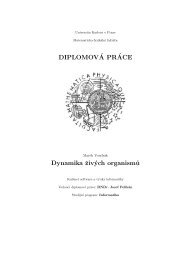MASTER THESIS Video Watermarking - Computer Graphics Group ...
MASTER THESIS Video Watermarking - Computer Graphics Group ...
MASTER THESIS Video Watermarking - Computer Graphics Group ...
Create successful ePaper yourself
Turn your PDF publications into a flip-book with our unique Google optimized e-Paper software.
Common geometric distortions – the watermark should be immune from<br />
geometric image operations (such as rotation, cropping and scaling).<br />
Subterfuge attacks: Collusion and Forgery – the watermark should be<br />
robust to collusion by multiple individuals who each possesses a differently<br />
watermarked copy of the same content combining their copies to destroy<br />
the watermark. Moreover, it should be impossible to combine the copies to<br />
create a new valid watermark.<br />
Unambiguous<br />
The retrieved watermark should uniquely identify the copyright owner of the<br />
content, or in case of fingerprinting applications, the authorized recipient of<br />
the content.<br />
In order for a watermark to be robust, it must be embedded into<br />
perceptually significant regions of video frames despite the risk of eventual<br />
fidelity distortion. The reason is quite simple: if the watermark were embedded<br />
in perceptually insignificant regions, it would be possible to remove it without<br />
severe quality degradation of the cover content.<br />
Further, perceptually significant regions should be chosen with respect to<br />
sensitivity of human visual system which is tuned to certain spatial frequencies<br />
and to particular spatial characteristics such as edge features.<br />
2.1 Watermark Classification<br />
There are several criteria how watermarks for images or video sequences<br />
can be classified.<br />
<strong>Watermarking</strong> techniques can be classified into spatial or frequency domain<br />
by place of application. Spatial domain watermarking is performed by modifying<br />
values of pixel color samples of a video frame (such as in [2]) whereas watermarks<br />
of frequency domain techniques are applied to coefficients obtained as the result<br />
of a frequency transform of either a whole frame or single block-shaped regions of<br />
a frame. Discrete Fourier Transform (watermarking using this transform is<br />
presented in [3]) and Discrete Wavelet Transform (in [4] or [5]) belong among<br />
whole-frame frequency transforms. The representative of the block frequency<br />
transform is Discrete Cosine Transform (in [6]). Classification into these groups<br />
is according to the way how the transforms are usually used in practice.<br />
<strong>Video</strong> sequences compressed by modern techniques offer another type of<br />
domain, motion vectors. <strong>Watermarking</strong> in this domain slightly alters length and<br />
direction of motion vectors (as in [7]). More information about motion vectors is<br />
provided in Chapter 3.<br />
Further, watermarks for video sequences can be classified by the range of<br />
application – e.g. hidden information carried by a watermark can be spread over<br />
all frames of the video sequence, then the whole sequence is necessary to retrieve<br />
9
















